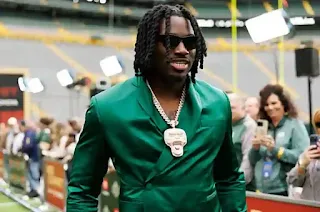Imagine this: you’re pumped after getting drafted in the first round of the NFL Draft, but instead of jumping into your pro career, you’re back on campus at your old college.
That’s exactly what Shemar Stewart—Cincinnati Bengals’ 17th overall pick in 2025—is doing. He’s a defensive end from Texas A&M who’s caught in a contract stalemate that’s raising eyebrows.
Shemar Stewart is a big, athletic defensive end—6'5", about 267 lb—with explosive speed and youth on his side (he’s only 21). In college, he suited up for Texas A&M and made a name for himself as a pass‑rushing force in the SEC.
In April 2025, he landed with the Cincinnati Bengals in the first round (17th pick), poised to strengthen their defensive front.
His role? Outside pass rusher in a 4–3 defense. That means he's expected to bring heat off the edge, chase down quarterbacks, bat down passes, and clog running lanes.
He’s sharing snaps with vets like Joseph Ossai and Myles Murphy, and as of now, looks like a rotational player—maybe more down the road, depending on his development and opportunity.
The Rookie Contract Drama—What’s the Rift?
After being picked 17th overall, Stewart was ready for his rookie deal—about a standard four‑year package around $19 million, fully guaranteed. But the Bengals tossed in a curveball: a “default clause.”
This clause lets the team yank future guarantees if he faces discipline—on‑ or off‑field. That type of clause? It’s nothing new in the NFL.
But for how the Bengals typically handle first‑rounders, it is. Stewart’s camp pushed back hard, insisting that nothing like this had come up in the previous picks’ contracts.
He even said, “I’m 100% right … I’m not asking for something y’all haven’t done before,” calling out the team for focusing more on tricky wording than wins.
Rookie holdouts aren’t unheard of. But a first‑rounder skipping practices? Especially a defensive player in their prime? That’s something else.
So What’s the Deal With Returning to College?
Here’s where it gets really interesting. As the contract standoff dragged on, word got out that Stewart has been back in College Station, showing up at Texas A&M facilities. And word has it he’s been training.
That sparked speculation—could he actually go back to school, play another college season, and re‑enter the draft next year? That would be nuts, right?
Well, NCAA rules say once you declare and stay out past a certain deadline, you can’t go back and play. But there’s a loophole: he could re‑enroll, sit out a year, and then enter the 2026 draft. Some even speculate about a lawsuit to challenge the rules.
On the flip side, insiders have clarified: nope, he’s not practicing with the Aggie team or suiting up for scrimmages—he’s just staying sharp on his home turf between camps, which is a super common thing, especially for players returning to their college towns in the offseason.
The Stakes: What’s on the Line?
For Stewart: He risks falling behind in NFL reps. If he doesn’t sign soon and training camp starts without him, he’ll be scrambling to catch up.
That could cost him valuable development, exposure, and momentum. On the flip side, he’s sitting on NIL earnings and doesn’t technically need the money immediately, giving him wiggle room to push for better terms.
For the Bengals: They’ve got meat on the contract table, but if he walks out or holds firm, they could lose a key defense piece before the season even starts. And if he really goes back to college or re‑enters the draft, the team risks losing a first‑rounder, too.
The deadline for trades is looming—around early August—so all eyes are watching to see if they’ll fold, flip, or stick.
For the NFL landscape: This could set a major precedent. A rookie going back, cashing in on NIL, and re‑drafting? If this happens, it’ll redefine how rookies, schools, and teams negotiate loonnggg detours in deal‑making.
Holdout or Hometown Hustle?
Some fans say it’s a power play—a rookie holding out to own his value. Others say it’s reckless: no practices, no team bonding, no plays under center yet—tough to turn around come game time. Tensions are high, and both sides are digging in.
Final Thoughts
This whole situation is a wild blend of modern college football drama (NIL, eligibility rules) and classic NFL business (rookie contracts, leverage, holdouts).
Shemar Stewart’s standing at the edge of college and pro football right now is a microcosm of how the game is evolving—and it’s just beginning.
Will he march back into that AFC North kickoff? Or will he hit “pause,” go back to Aggieland, and rerun his draft stock next spring? Either way, it’s a fascinating story unfolding in real time.




.jpg)


0 Comments